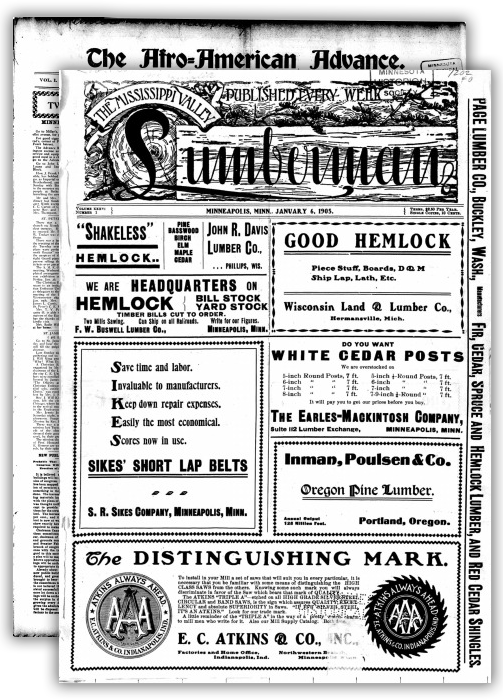
hub
Introduction
titles
About the titles
corporations foundations
Search the Newspapers
hub-faq
F.A.Q.
Choose a Menu
-
hubIntroduction
-
titlesAbout the titles
-
corporations foundationsSearch the Newspapers
-
hub-faqF.A.Q.
Duluth rip-saw (Duluth, Minn.) 1917-1926 Browse the title

John Loyal Morrison published the first issue of his notorious muckraking scandal sheet, the Duluth Rip-saw, in Duluth, Minnesota, on March 24, 1917. Morrison, a devout Christian, used the Rip-saw in his one-man crusade against what he viewed as the evils of alcohol, gambling, violence, and prostitution, and the local politicians and lawmen who participated in or turned a blind eye to these vices.
Morrison declared the Rip-saw to be “Duluth’s leading independent paper.” Issues were generally four pages with seven columns and published every other Saturday. As a “conservative reformer,” Morrison used the newspaper to “saw” and “rip” into “city moneyed ‘autocrats.’” The “Sawdust and Shavings” column included fiery statements against his targets of the week. In the July 7, 1917 issue, the Rip-saw reported that “flunkies” of Saint Louis County auditor “King” Odin Halden were trying to “show their teeth” to Morrison after he charged Halden with committing “petty graft” by making courthouse employees work at his private home without pay. In the same issue, Morrison claimed Duluth police chief Robert McKercher was “going blind” for not acknowledging illegal bars and prostitution in the city. With striking headlines and sensational reporting, public interest and sales increased, allowing Morrison to continue publishing without advertisers. The March 8, 1918 issue claimed 23,000 subscribers, a large jump from the 5,000 subscribers claimed in September 1917.
Morrison chaired a committee of residents of Duluth’s South First Avenue working to quash distinctly African American prostitution, and his reporting of the problem in the Rip-saw was racially charged. One headline of September 9, 1919, read, “Dark girls woo white men.” Bubbling racial tensions in Duluth boiled over in June 1920 when three Black circus workers falsely accused of rape were seized from the city jail without police intervention and publicly lynched by a large mob. In the June 26, 1920 issue of the Rip-saw, Morrison called the accused “moral degenerates” and the mob “hoodlums.”
The Rip-saw’s attacks eventually led Morrison into court. In the 1924 general elections, he targeted a few candidates, including Hibbing mayor Victor L. Power, state senator Michael Boylan, and Cass County probate judge Bert Jamison. In the October 25, 1924 issue, Morrison gave Boylan what he termed a “good editorial spanking” after Morrison claimed Boylan threatened by wire to kill him and end the Rip-saw. Morrison saw Jamison as unfit to serve due to gambling and other grotesque improprieties, while he viewed Power as a “corporation candidate,” in the pocket of corporate interests. In response to Jamison and Power filing charges against him for criminal libel and obscenity, Morrison published a threatening letter he received from Boylan in the November 1, 1924 issue.
On April 7, 1925, the Minnesota state legislature passed the Minnesota Public Nuisance or “Gag” Law, sponsored by Boylan with the express purpose of shutting down the Rip-saw. With this statute, a judge could order the stoppage of a publication seen as “obscene, lewd, and lascivious” without a jury. Undeterred, Morrison charged Minneapolis mayor George Emerson Leach with adultery in 1926, leading to a warrant for Morrison’s arrest and a restraining order placed on the Rip-saw. Morrison went to Superior, Wisconsin, to escape authorities, but became ill and died of a “brain clot” on May 18, 1926, ending his newspaper. The U.S. Supreme Court ruled the gag law unconstitutional in 1931 in the case of Near v. Minnesota, a landmark decision protecting the freedom of the press.
Minnesota Digital Newspaper Hub
The Minnesota Digital Newspaper Hub is a searchable website from the Minnesota Historical Society that makes millions of pages of Minnesota newspapers available online.
The Hub contains geographically and culturally diverse newspapers published between 1849 and today. Due to potential copyright restrictions most issues published after 1977 can only be accessed from the Gale Family Library at the Minnesota History Center.
The Minnesota Digital Newspaper Hub incorporates Minneapolis Tribune titles previously found on a stand-alone website, foreign-language titles, and much more, with new titles and date ranges continuously being added.
The Minnesota Historical Society's newspaper digitization program is made possible through support from the National Endowment for the Humanities and the National Digital Newspaper Program (NDNP), the Legacy Amendment's Arts and Cultural Heritage Fund through the vote of Minnesotans on Nov. 4, 2008, SELCO (Southeastern Libraries Cooperating) through a grant from the Minnesota Arts and Cultural Heritage Fund for Libraries, and many other organizations and individual donors.
Material in the Digital Newspaper Hub may be protected by copyright law (U.S. Code Title 17).
Looking for more information on MNHS digital newspaper collections? Visit Digital Newspapers at MNHS
